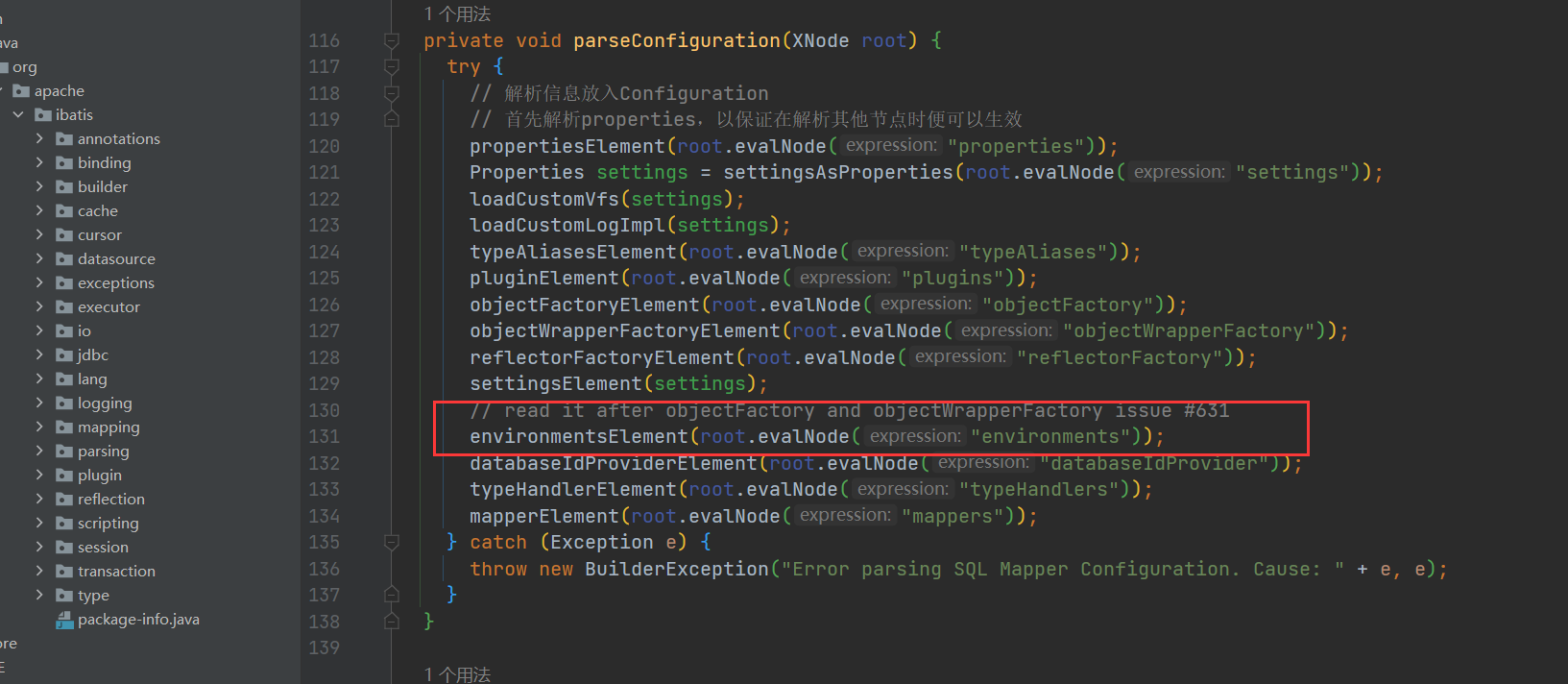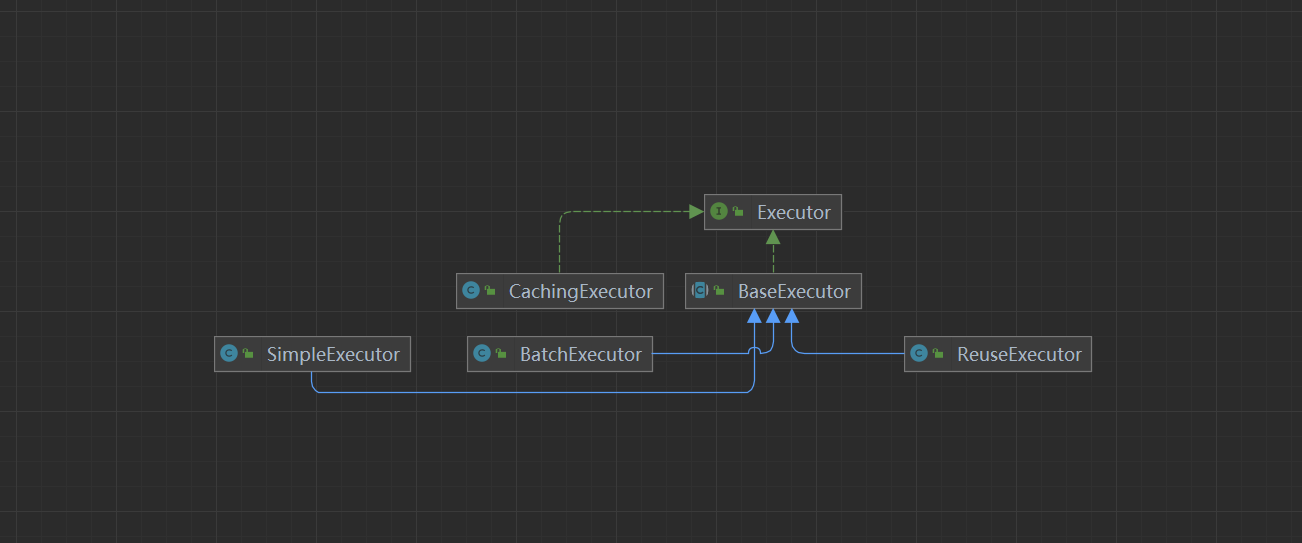5-SqlSession的创建
使用 MyBatis 的主要 Java 接口就是 SqlSession。你可以通过这个接口来执行命令,获取映射器实例和管理事务。在介绍 SqlSession 接口之前,我们先来了解如何获取一个 SqlSession 实例。SqlSessions 是由 SqlSessionFactory 实例创建的。SqlSessionFactory 对象包含创建 SqlSession 实例的各种方法。而 SqlSessionFactory 本身是由 SqlSessionFactoryBuilder 创建的,它可以从 XML、注解或 Java 配置代码来创建 SqlSessionFactory。
一 SqlSession的创建
@Test
void contextLoads() {
// 第一阶段:MyBatis的初始化阶段
String resource = "mybatis-config.xml";
// 得到配置文件的输入流
InputStream inputStream = null;
try {
inputStream = Resources.getResourceAsStream(resource);
} catch (IOException e) {
e.printStackTrace();
}
// 得到SqlSessionFactory
SqlSessionFactory sqlSessionFactory = new SqlSessionFactoryBuilder().build(inputStream);
// 第二阶段:数据读写阶段
try (SqlSession session = sqlSessionFactory.openSession()) {
// 找到接口对应的实现
UserMapper userMapper = session.getMapper(UserMapper.class);
// 组建查询参数
User userParam = new User();
userParam.setSchoolname("Sunny School");
// 调用接口展开数据库操作
List<User> userList = userMapper.queryAllByLimit(userParam);
// 打印查询结果
for (User user : userList) {
System.out.println("name : " + user.getName() + " ; email : " + user.getEmail());
}
}
}
- 我们来看看SqlSession的创建是如何创建的,在上两篇文件中完成配置文件的解析返回SqlSessionFactory
// 第二阶段:数据读写阶段
try (SqlSession session = sqlSessionFactory.openSession()) {
- 可以通过调式看出,我们的SqlSessionFactory的实现是DefaultSqlSessionFactory
DefaultSqlSessionFactory
@Override
public SqlSession openSession() {
return openSessionFromDataSource(configuration.getDefaultExecutorType(), null, false);
}
public enum ExecutorType {
SIMPLE, // 为每个语句创建新的预处理语句
REUSE, // 复用
BATCH // 执行批量操作
}
/**
* 从数据源中获取SqlSession对象
* @param execType 执行器类型
* @param level 事务隔离级别
* @param autoCommit 是否自动提交事务
* @return SqlSession对象
*/
private SqlSession openSessionFromDataSource(ExecutorType execType, TransactionIsolationLevel level, boolean autoCommit) {
Transaction tx = null;
try {
// 找出要使用的指定环境
final Environment environment = configuration.getEnvironment();
// 从环境中获取事务工厂
final TransactionFactory transactionFactory = getTransactionFactoryFromEnvironment(environment);
// 从事务工厂中生产事务
tx = transactionFactory.newTransaction(environment.getDataSource(), level, autoCommit);
// 创建执行器
final Executor executor = configuration.newExecutor(tx, execType);
// 创建DefaultSqlSession对象
return new DefaultSqlSession(configuration, executor, autoCommit);
} catch (Exception e) {
closeTransaction(tx); // may have fetched a connection so lets call close()
throw ExceptionFactory.wrapException("Error opening session. Cause: " + e, e);
} finally {
ErrorContext.instance().reset();
}
}
主要包含以下几个步骤:
- 首先从configuration获取Environment对象,里面主要包含了DataSource和TransactionFactory对象
- 创建TransactionFactory对象
- 创建Transaction对象
- 从configuration获取Executor
- 构造DefaultSqlSession对象
1.1 获取environments配置元素
//配置environment环境
<environments default="development">
<environment id="development">
/** 事务配置 type= JDBC、MANAGED
* 1.JDBC:这个配置直接简单使用了JDBC的提交和回滚设置。它依赖于从数据源得到的连接来管理事务范围。
* 2.MANAGED:这个配置几乎没做什么。它从来不提交或回滚一个连接。
*/
<transactionManager type="JDBC" />
/** 数据源类型:type = UNPOOLED、POOLED、JNDI
* 1.UNPOOLED:这个数据源的实现是每次被请求时简单打开和关闭连接。
* 2.POOLED:这是JDBC连接对象的数据源连接池的实现。
* 3.JNDI:这个数据源的实现是为了使用如Spring或应用服务器这类的容器
*/
<dataSource type="POOLED">
<property name="driver" value="com.mysql.jdbc.Driver" />
<property name="url" value="jdbc:mysql://localhost:3306/xhm" />
<property name="username" value="root" />
<property name="password" value="root" />
//默认连接事务隔离级别
<property name="defaultTransactionIsolationLevel" value=""/>
</dataSource>
</environment>
</environments>
- 解析我们配置文件中的environment配置元素,具体解析过程请参考前面的文章。
 XMLConfigBuilder
XMLConfigBuilder
// 解析我们配置文件中的environment配置元素
private void environmentsElement(XNode context) throws Exception {
if (context != null) {
if (environment == null) {
// 获取 default 属性
environment = context.getStringAttribute("default");
}
for (XNode child : context.getChildren()) {
// 获取 id 属性
String id = child.getStringAttribute("id");
/*
* 检测当前 environment 节点的 id 与其父节点 environments 的属性 default
* 内容是否一致,一致则返回 true,否则返回 false
* 将其default属性值与子元素environment的id属性值相等的子元素设置为当前使用的Environment对象
*/
if (isSpecifiedEnvironment(id)) {
// 将environment中的transactionManager标签转换为TransactionFactory对象
TransactionFactory txFactory = transactionManagerElement(child.evalNode("transactionManager"));
// 将environment中的dataSource标签转换为DataSourceFactory对象
DataSourceFactory dsFactory = dataSourceElement(child.evalNode("dataSource"));
// 创建 DataSource 对象
DataSource dataSource = dsFactory.getDataSource();
Environment.Builder environmentBuilder = new Environment.Builder(id)
.transactionFactory(txFactory)
.dataSource(dataSource);
// 构建 Environment 对象,并设置到 configuration 中
configuration.setEnvironment(environmentBuilder.build());
}
}
}
}
1.2 获取事务工厂
DefaultSqlSessionFactory
private TransactionFactory getTransactionFactoryFromEnvironment(Environment environment) {
if (environment == null || environment.getTransactionFactory() == null) {
// 委托事务工厂
return new ManagedTransactionFactory();
}
// 我们配置的事务工厂JdbcTransactionFactory
return environment.getTransactionFactory();
}

- JdbcTransaction由JDBC进行事务管理
JdbcTransaction
// 由JDBC进行事务管理
public class JdbcTransaction implements Transaction {
private static final Log log = LogFactory.getLog(JdbcTransaction.class);
// 数据库连接
protected Connection connection;
// 数据源
protected DataSource dataSource;
// 事务隔离级别
protected TransactionIsolationLevel level;
// 是否自动提交事务
protected boolean autoCommit;
public JdbcTransaction(DataSource ds, TransactionIsolationLevel desiredLevel, boolean desiredAutoCommit) {
dataSource = ds;
level = desiredLevel;
autoCommit = desiredAutoCommit;
}
public JdbcTransaction(Connection connection) {
this.connection = connection;
}
@Override
public Connection getConnection() throws SQLException {
if (connection == null) {
openConnection();
}
return connection;
}
/**
* 提交事务
* @throws SQLException
*/
@Override
public void commit() throws SQLException {
// 连接存在且不会自动提交事务
if (connection != null && !connection.getAutoCommit()) {
if (log.isDebugEnabled()) {
log.debug("Committing JDBC Connection [" + connection + "]");
}
// 调用connection对象的方法提交事务
connection.commit();
}
}
/**
* 回滚事务
* @throws SQLException
*/
@Override
public void rollback() throws SQLException {
if (connection != null && !connection.getAutoCommit()) {
if (log.isDebugEnabled()) {
log.debug("Rolling back JDBC Connection [" + connection + "]");
}
connection.rollback();
}
}
@Override
public void close() throws SQLException {
if (connection != null) {
resetAutoCommit();
if (log.isDebugEnabled()) {
log.debug("Closing JDBC Connection [" + connection + "]");
}
connection.close();
}
}
protected void setDesiredAutoCommit(boolean desiredAutoCommit) {
try {
if (connection.getAutoCommit() != desiredAutoCommit) {
if (log.isDebugEnabled()) {
log.debug("Setting autocommit to " + desiredAutoCommit + " on JDBC Connection [" + connection + "]");
}
connection.setAutoCommit(desiredAutoCommit);
}
} catch (SQLException e) {
// Only a very poorly implemented driver would fail here,
// and there's not much we can do about that.
throw new TransactionException("Error configuring AutoCommit. "
+ "Your driver may not support getAutoCommit() or setAutoCommit(). "
+ "Requested setting: " + desiredAutoCommit + ". Cause: " + e, e);
}
}
protected void resetAutoCommit() {
try {
if (!connection.getAutoCommit()) {
// MyBatis does not call commit/rollback on a connection if just selects were performed.
// Some databases start transactions with select statements
// and they mandate a commit/rollback before closing the connection.
// A workaround is setting the autocommit to true before closing the connection.
// Sybase throws an exception here.
if (log.isDebugEnabled()) {
log.debug("Resetting autocommit to true on JDBC Connection [" + connection + "]");
}
connection.setAutoCommit(true);
}
} catch (SQLException e) {
if (log.isDebugEnabled()) {
log.debug("Error resetting autocommit to true "
+ "before closing the connection. Cause: " + e);
}
}
}
protected void openConnection() throws SQLException {
if (log.isDebugEnabled()) {
log.debug("Opening JDBC Connection");
}
connection = dataSource.getConnection();
if (level != null) {
connection.setTransactionIsolation(level.getLevel());
}
setDesiredAutoCommit(autoCommit);
}
@Override
public Integer getTimeout() throws SQLException {
return null;
}
}
JdbcTransaction主要维护了一个默认autoCommit为false的Connection对象,对事物的提交,回滚,关闭等都是接见通过Connection完成的。
1.3 获取执行器Executor

/**
* 创建一个执行器
* @param transaction 事务
* @param executorType 数据库操作类型
* @return 执行器
*/
public Executor newExecutor(Transaction transaction, ExecutorType executorType) {
executorType = executorType == null ? defaultExecutorType : executorType;
executorType = executorType == null ? ExecutorType.SIMPLE : executorType;
Executor executor;
// 根据数据操作类型创建实际执行器
if (ExecutorType.BATCH == executorType) {
// 批处理执行器
executor = new BatchExecutor(this, transaction);
} else if (ExecutorType.REUSE == executorType) {
// 可以重用执行器
executor = new ReuseExecutor(this, transaction);
} else {
//一个简单的执行器
executor = new SimpleExecutor(this, transaction);
}
// 根据配置文件中settings节点cacheEnabled配置项确定是否启用缓存
if (cacheEnabled) { // 如果配置启用缓存
// 使用CachingExecutor装饰实际执行器
executor = new CachingExecutor(executor);
}
// 为执行器增加拦截器(插件),以启用各个拦截器的功能
executor = (Executor) interceptorChain.pluginAll(executor);
return executor;
}
- 执行器的类型,我们来看看执行器的接口信息
 Executor
Executor
public interface Executor {
ResultHandler NO_RESULT_HANDLER = null;
// 数据更新操作,其中数据的增加、删除、更新均可由该方法实现
int update(MappedStatement ms, Object parameter) throws SQLException;
// 数据查询操作,返回结果为列表形式
<E> List<E> query(MappedStatement ms, Object parameter, RowBounds rowBounds, ResultHandler resultHandler, CacheKey cacheKey, BoundSql boundSql) throws SQLException;
// 数据查询操作,返回结果为列表形式
/**
* 执行查询操作
* @param ms 映射语句对象
* @param parameter 参数对象
* @param rowBounds 翻页限制
* @param resultHandler 结果处理器
* @param <E> 输出结果类型
* @return 查询结果
* @throws SQLException
*/
<E> List<E> query(MappedStatement ms, Object parameter, RowBounds rowBounds, ResultHandler resultHandler) throws SQLException;
// 数据查询操作,返回结果为游标形式
<E> Cursor<E> queryCursor(MappedStatement ms, Object parameter, RowBounds rowBounds) throws SQLException;
// 清理缓存
List<BatchResult> flushStatements() throws SQLException;
// 提交事务
void commit(boolean required) throws SQLException;
// 回滚事务
void rollback(boolean required) throws SQLException;
// 创建当前查询的缓存键值
CacheKey createCacheKey(MappedStatement ms, Object parameterObject, RowBounds rowBounds, BoundSql boundSql);
// 本地缓存是否有指定值
boolean isCached(MappedStatement ms, CacheKey key);
// 清理本地缓存
void clearLocalCache();
// 懒加载
void deferLoad(MappedStatement ms, MetaObject resultObject, String property, CacheKey key, Class<?> targetType);
// 获取事务
Transaction getTransaction();
// 关闭执行器
void close(boolean forceRollback);
// 判断执行器是否关闭
boolean isClosed();
// 设置执行器包装
void setExecutorWrapper(Executor executor);
}
executor包含了Configuration和刚刚创建的Transaction,默认的执行器为SimpleExecutor,如果开启了二级缓存(默认开启),则CachingExecutor会包装SimpleExecutor,然后依次调用拦截器的plugin方法返回一个被代理过的Executor对象,记住这个地方,后面Sql语句具体的执行是交给执行器来进行处理的。
1.4 构建DefaultSqlSession
return new DefaultSqlSession(configuration, executor, autoCommit);
public class DefaultSqlSession implements SqlSession {
// 配置信息
private final Configuration configuration;
// 执行器
private final Executor executor;
// 是否自动提交
private final boolean autoCommit;
// 缓存是否已经被污染
private boolean dirty;
// 游标列表
private List<Cursor<?>> cursorList;
public DefaultSqlSession(Configuration configuration, Executor executor, boolean autoCommit) {
this.configuration = configuration;
this.executor = executor;
this.dirty = false;
this.autoCommit = autoCommit;
}
}
 SqlSession的所有查询接口最后都归结位Exector的方法调用。后面文章我们来分析其调用流程。
SqlSession的所有查询接口最后都归结位Exector的方法调用。后面文章我们来分析其调用流程。